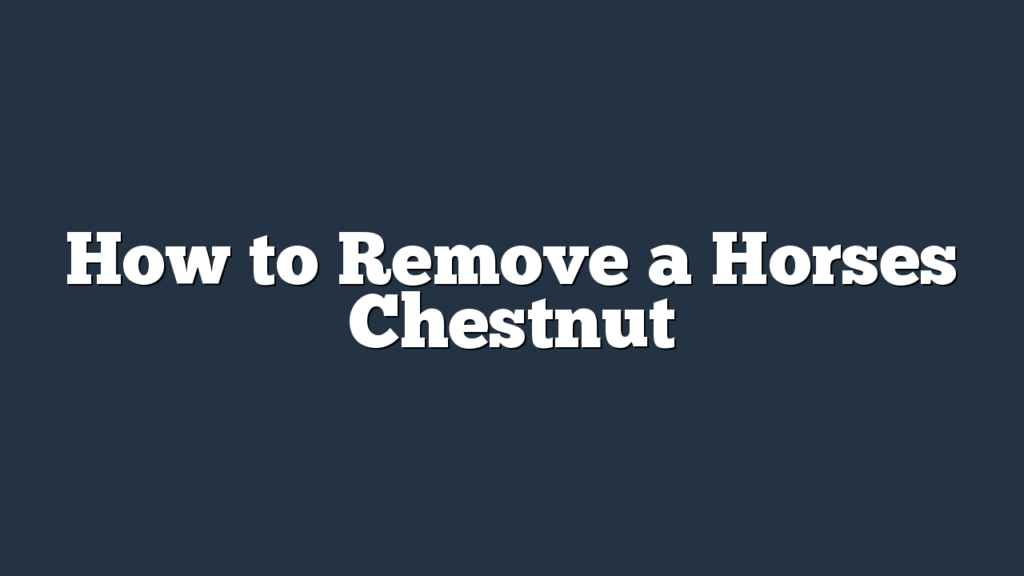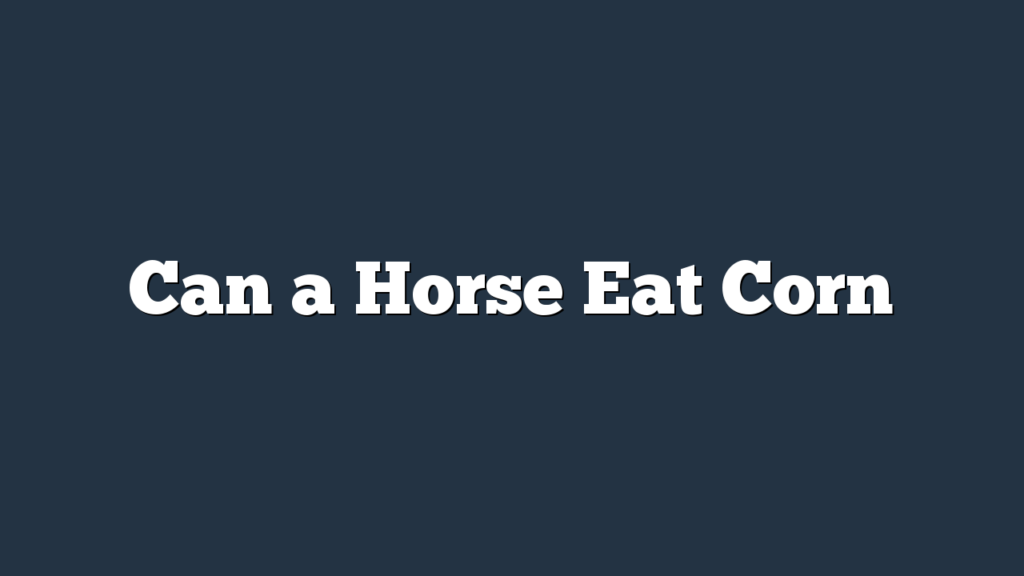Are you tired of dealing with your horse’s chestnuts? In this article, we’ll show you how to remove them efficiently and painlessly.
You’ll learn the step-by-step process, from understanding what chestnuts are to the aftercare and preventive measures you can take.
With the right tools and supplies, you’ll be able to tackle this task with ease. Say goodbye to those pesky chestnuts and give your horse the comfort it deserves.
Let’s get started!
Understanding Horse Chestnuts
You need to understand what horse chestnuts are before attempting to remove them.
Horse chestnuts are the seeds of the horse chestnut tree, scientifically known as Aesculus hippocastanum. These trees are native to the Balkan Peninsula but are now commonly found in many parts of the world.
Horse chestnuts have been used for various purposes throughout history, making them valuable in many ways.
One of the primary uses of horse chestnuts is in traditional medicine. The seeds contain a compound called aescin, which has anti-inflammatory properties. It’s often used to treat conditions like varicose veins and hemorrhoids. Additionally, horse chestnuts have been used in herbal remedies for their potential to improve circulation and reduce swelling.
Aside from their medicinal uses, horse chestnuts also have benefits in other areas. The wood of the horse chestnut tree is dense and durable, making it suitable for crafting furniture and other wooden products. The tree’s canopy provides shade and shelter for various wildlife species. Furthermore, horse chestnut trees are admired for their beautiful flowers, which bloom in spring and add aesthetic value to parks and gardens.
Understanding the uses and benefits of horse chestnuts is important before attempting to remove them. It helps you appreciate their value and make informed decisions about their management.
Preparing for Chestnut Removal
To prepare for removing a horse’s chestnut, gather the necessary tools and ensure a calm and secure environment. Before attempting to remove the chestnut, it’s important to groom the area around it. Start by cleaning the horse’s leg thoroughly with warm water and mild soap. Use a soft brush to remove any dirt or debris that may be stuck to the skin. This will help prevent any infection or irritation during the removal process.
Next, gather the tools needed for chestnut removal. You’ll need a hoof pick, a pair of clean and sharp scissors, and a pair of gloves. The hoof pick will be used to gently loosen the chestnut from the surrounding skin. Be careful not to apply too much pressure, as this can cause discomfort or injury to the horse.
When it comes to chestnut removal techniques, there are a few options to consider. Some people prefer to remove the chestnut by twisting it gently with their fingers. Others may choose to carefully trim the chestnut with scissors. Whichever method you choose, remember to work slowly and be gentle to avoid causing any pain or stress to the horse.
Tools and Supplies Needed
Gathering the necessary tools and supplies is essential when preparing to remove a horse’s chestnut. To remove chestnuts safely, there are a few key items you’ll need.
First, you’ll need a pair of clean, sharp hoof nippers. These will allow you to easily trim away the excess skin and hair around the chestnut, making it easier to remove. Additionally, you’ll need a small, sharp knife or hoof pick to carefully cut away any remaining skin or tissue.
It’s important to note that using the correct tools is crucial for a safe and successful chestnut removal. Using dull or improperly sized tools can lead to injury or discomfort for your horse. So, be sure to invest in a good quality pair of hoof nippers and a sharp knife or hoof pick.
When removing chestnuts, it’s also important to avoid common chestnut removal mistakes. One common mistake isn’t properly cleaning and disinfecting the tools before and after use. This can lead to the spread of infection and potential health issues for your horse. So, be sure to clean your tools thoroughly with a disinfectant solution before and after each use.
Step-by-Step Chestnut Removal Process
When approaching the step-by-step chestnut removal process, it is crucial to prioritize safety and precision. By following the correct chestnut removal techniques and safety precautions, you can ensure the well-being of your horse and achieve successful removal.
First, gather all the necessary tools and supplies mentioned earlier in the article. This includes a hoof pick, gloves, clean towels, and a mild antiseptic solution. Once you have everything ready, you can proceed with the following steps:
| Step | Description |
|---|---|
| 1 | Start by thoroughly cleaning the horse’s hooves using a hoof pick. Make sure to remove any dirt or debris that may be covering the chestnut. |
| 2 | Put on a pair of gloves to protect your hands from potential injury. |
| 3 | Gently grasp the chestnut with your fingers and apply slight pressure to loosen it. Avoid using excessive force to prevent causing discomfort or pain to the horse. |
| 4 | Once the chestnut is loosened, carefully pull it out in a straight and steady motion. If it doesn’t come out easily, stop and consult a veterinarian for further assistance. |
Aftercare and Preventive Measures
Now that you have successfully removed the chestnut from your horse’s hoof, it’s important to focus on aftercare and preventive measures to ensure their continued well-being.
After the removal process, it’s crucial to keep the area clean and properly bandaged to prevent infection. Regularly inspect the hoof for any signs of swelling, redness, or discharge, as these may indicate an infection or other complications.
Additionally, it’s essential to maintain good hoof hygiene to reduce chestnut growth in the future.
To promote healing and prevent the recurrence of chestnuts, you can try incorporating natural remedies into your horse’s hoof care routine. One effective natural remedy is using apple cider vinegar as a hoof soak. Simply mix equal parts of apple cider vinegar and water in a bucket and soak your horse’s hooves for about 15 minutes once or twice a week. This can help soften the chestnut and make it easier to remove in the future.
Furthermore, consider adding a balanced diet rich in essential nutrients to support overall hoof health. A diet that includes biotin, zinc, and omega-3 fatty acids can help strengthen the hooves and reduce the likelihood of chestnut formation.
Frequently Asked Questions
How Long Does It Take for a Horse’s Chestnut to Grow Back After Removal?
It takes some time for a horse’s chestnut to grow back after removal. The exact duration may vary, but with proper care and regular cleaning, it should typically regenerate within a few weeks.
Can I Remove My Horse’s Chestnut Myself or Do I Need to Hire a Professional?
You can remove your horse’s chestnut yourself, but hiring a professional has its benefits. DIY chestnut removal allows you to save money, while professional removal ensures proper technique and reduces the risk of injury.
Are There Any Potential Risks or Complications Associated With Chestnut Removal?
Potential complications and safety concerns can arise when removing a horse’s chestnut. It is important to be aware of the risks involved and consider seeking professional help to ensure the procedure is done safely.
How Often Should I Remove My Horse’s Chestnut?
You should consult a professional to determine the frequency of chestnut removal for your horse. They will assess your horse’s needs and advise you on the appropriate schedule for removing their chestnuts.
Can the Chestnut Removal Process Cause Any Pain or Discomfort to the Horse?
Removing your horse’s chestnut may cause some temporary pain or discomfort, but it is a necessary part of the healing process. Be gentle and patient during the procedure to minimize any discomfort for your horse.
Conclusion
In conclusion, removing a horse’s chestnut can be a simple and straightforward process when done with the right tools and precautions. By understanding the nature of horse chestnuts and following the step-by-step removal process, you can ensure the health and comfort of your horse.
Remember to provide proper aftercare and take preventive measures to prevent the formation of new chestnuts. With patience and care, your horse will be happy and free from any discomfort caused by chestnuts.



